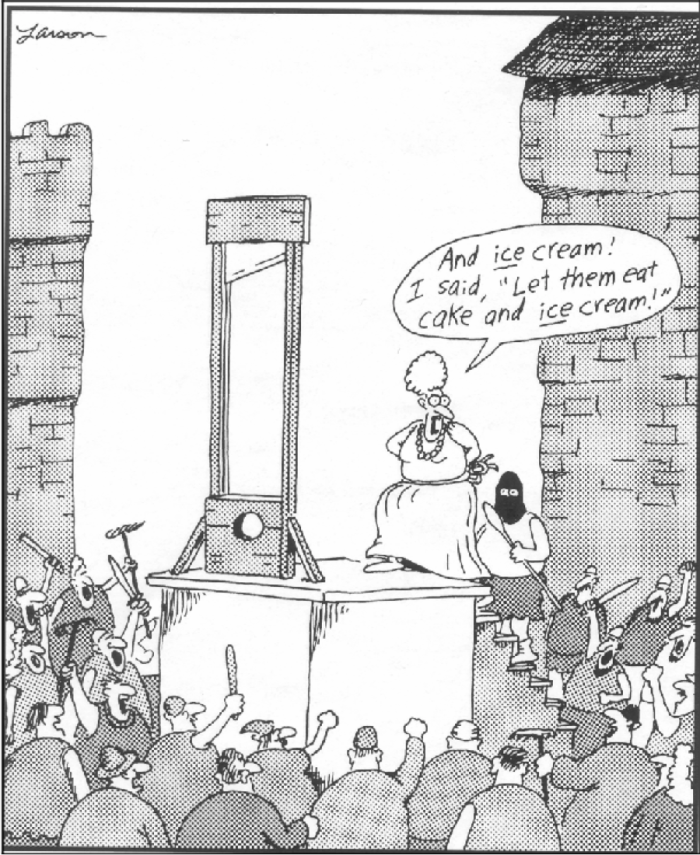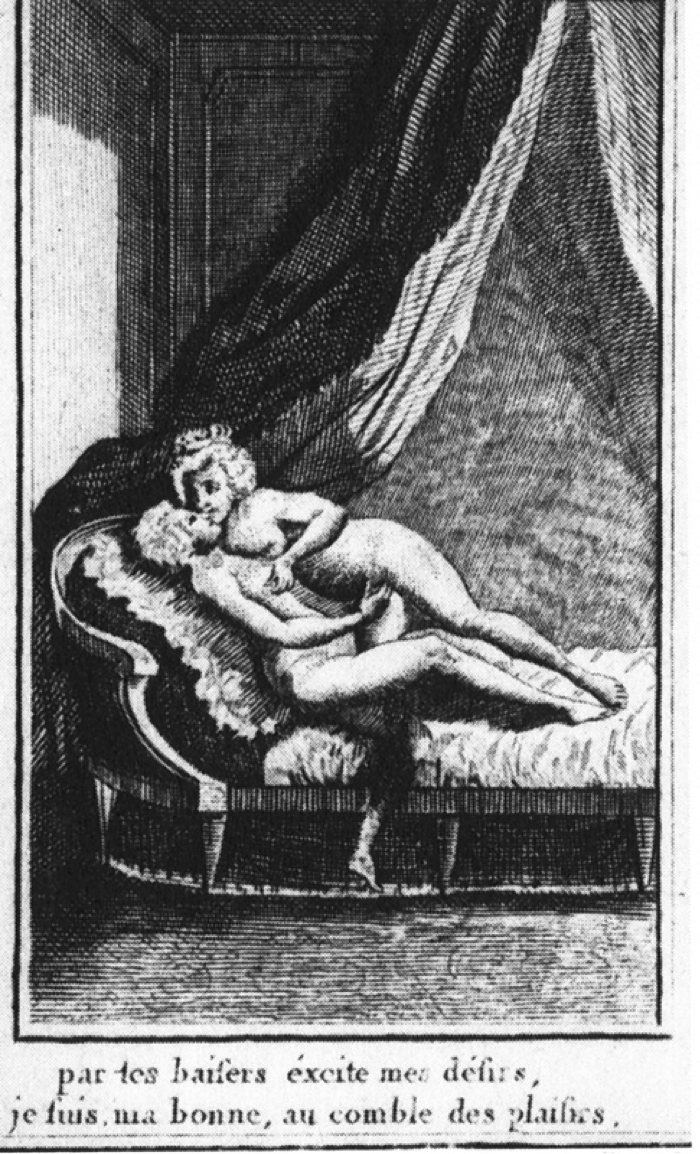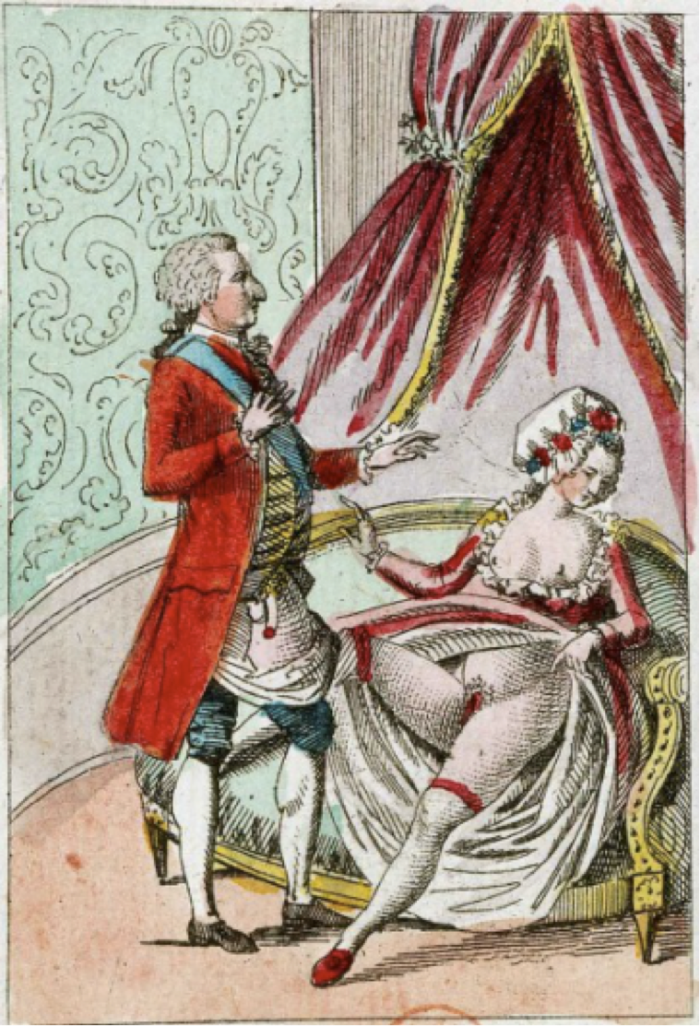
“I said, ‘Let them eat cake and ice cream!’” So cries a moribund Marie Antoinette as she climbs the final step to the Guillotine platform in a satirical The Far Side cartoon by illustrator Gary Larsen (Figure 1). The cartoon is aptly titled, “Marie Antoinette’s last-ditch effort to save her head.” As great comedians do, Larsen has infused both truth and irony into his work, though in this case probably more than even he realized. Marie Antoinette, of course, never said, “Let them eat cake,” but then she didn’t do a lot of things that were alleged by the Parisian rumor mill in the years from 1789 to her execution in 1793. Yet it was these very rumors, many of them explicitly or semi-pornographic in nature, that ultimately led to her death. Rumors of Marie Antoinette’s depraved behavior did more than get her beheaded, however. They played an instigating role in the French Revolution itself, both by fueling important pivots in the Revolution like the women’s march to Versailles and by helping to construct a milieu of opposition against absolutism and royal excess, ultimately undermining the legitimacy and authority of the French monarchy.
Unlike today, the pornography of revolutionary France carried with it important political messages. In the years after 1794, and certainly by the 1810s, pornography had been largely transformed into the explicitly sexual genre we know today.[1] But if we envision the pornography of the last two hundred years as designed solely to titillate and incite sexual feelings, we must view its history before this time as a form of expression that used the shock of sex as an instrument to convey other messages, often censuring political or religious figures, but also directly challenging social and moral conventions.[2] “Pornography was the name for a cultural battle zone,” wrote Lynn Hunt; quoting the historian Walter Kendrick she continued, “’pornography’ names an argument, not a thing.[3]” This fact is clearly evident if one examines the basis of government regulation during this era, which was focused on repression of unrest and sedition rather than expurgation of licentious material in the name of public decency.[4]
Though it was during the Revolution itself, and directly preceding it, that the largest effusion of political pornography was released, between the years of 1787 and 1792 there were important precursors that would later shape the direction of revolutionary erotic libel.[5] To be sure, all political elites, be they revolutionary or royalist, got a healthy dose of pornographic censure. But the orientation of this material was aimed disproportionately toward Marie Antoinette. “The avalanche of defamation that overwhelmed her between 1789 and her execution on October 16, 1793, has no parallel in the history of vilification[6]”, wrote historian Robert Darnton. Perhaps the most shocking evidence of the libel’s widespread dissemination comes from Boyer de Nîmes’s Histoire des caricatures de la révolte des Francais in which Boyer notes that “antiqueen pamphlets were sold at the gate to the Tuileries palace, in its gardens and right under the King’s window.”[7] These rumors of erotic manipulation and debauchery were so vast as to replace the real Marie Antoinette with a ribald fiction where imagined narratives of her private life rode roughshod over any actual movements the Queen might have made.
Though only ten percent of anti-Marie Antoinette material was published before 1789 a body of antiqueen material had already emerged during the pre-revolutionary era that would lay the foundation for the later groundswell.[8] For instance, an estimate by an anonymous expert on the matter, dating back to the 1770s, claimed to have found 126 pamphlets about the Queen he found to be libertine.[9] Considering that Essais Historiques alone was thought to have sold more than twenty thousand copies[10], it is probable that the circulation of antiqueen pamphlets totaled in the hundreds of thousands over the course of her rule. No doubt most of this material was generated from revolutionaries; a fraction, however, also came from the court itself. The author of Portefeuille d’un talon rouge, for instance, admitted the basis for his publication came from courtiers.[11]
Political pornography had a rather direct affect on public opinion during the Revolution and pre-Revolutionary epochs. Robert Darnton in his book Forbidden Best-Sellers of Pre-Revolutionary France suggests that gossip and printed libel reinforced one another, interacting also with public opinion in an iterative fashion.[12] “The contemporary view of events was as important as the events themselves; in fact, it cannot be separated from them,” he wrote.[13] One sure sign that pornography was particularly influential during the period of the Revolution was the way the narratives from pornography began to creep over into nonpornographic material. For instance, in 1792 a series of pamphlets were circulated listing a number of “political enemies who deserved immediate punishment.[14]” The names themselves had been lifted directly from pornographic libel of prominent men who had had illicit relations with the Queen. Certainly this blurring of the pornographic and the political publishing outlets of pre-revolutionary and revolutionary France goes a long way toward suggesting the type of public option at play during the era. It was not only the mood that was affected, however, but revolutionary action as well.
One such crucial event in the Revolution was the relocation of political power from Versailles to Paris. The episode began on the night of 1 October 1789 when the Queen had honored a regiment from Flanders, signaling a possible attempt by Louis XVI to reestablish order and authority. Making matters worse, the tricolored cockade was reportedly trampled over. Several days later on the 5th of October women met at the Hôtel de Ville and marched to Versailles. When, the next day, the royal family was brought back to Paris it signaled both a shift in the physical center of power and a cementing of the fact that it was now the people, not the monarchy, that truly controlled France. Bread prices no doubt played a major role, but so did rumors about the night of 1 October. It was portrayed not merely as “a ceremony”, or less officially “a party”, but instead described as yet another “orgy” between the Queen and her ever-growing harem, this time the King’s newly arrived soldiers.[15] Certainly this alleged debauchery, which was made all the more probable by years of pornographic antiqueen pamphlets, played a part in the excitation of the women.
The supposed debauchery of the Queen had grown over time, circumscribing an increasingly large coterie of high officials, nobles, and ministers. To understand how large this group had truly become, consider a post-revolutionary pamphlet depicting “Marie Antoinette in amorous embrace with just about everyone imaginable: her first supposed lover, a German officer; the aged Louis XV; Louis XVI impotent; the comte d’Artois; various women; various ménages á trois with two women and a man; the cardinal de Rohan of the Diamond Necklace Affair; Lafayete; Barnave, and so on.”[16]
Depictions of the Queen nearly always included group sex, homosexuality, and incest, since these acts had come to represent the decadence of political elites[17]. This decadence was largely echoed in what would be the ultimate piece of libel against Marie Antoinette: the bill of indictment at her trial. In the midst of a serious financial crisis in France she had prodigally spent on “disorderly pleasures” and been “the scourge and the bloodsucker of the French.”[18] So lecherous was her sexual appetite that “she had not stopped short of indulging herself with Louis-Charles Capet, her son…indecencies whose idea and name make us shudder with horror.”[19] And it was believed that through the use of bodily and verbal manipulation of Lafayette, Louis XVI, and his brothers, she had puppeteered counterrevolutionary movements during the opening years of the French Revolution.[20] There was, as there usually is, a modicum of truth to these rumors. The Queen did spend with ferocity, but it was mainly directed toward fashion for her and her inner circle, or on parties of a much more innocent nature than those alleged.[21]
The Queen was not the only woman of note to be censured in such a harsh manner. One of the most important antecedents to the revolutionary attacks against Marie Antoinette wasn’t aimed at the Queen herself, but rather Madam du Barry, King Louis XV’s Maîtresse-en-titre (head mistress). An anonymous poet, for example, went so far as to imply that du Barry would bring down all of France:
It seems to be your [France’s] destiny
To be subjugated to women
Your salvation came from the Maiden [Joan of Arc]
Your death will come from the Whore [du Barry][22]
It is easy to see here the attacks against du Barry were later echoed in the trial of Marie Antoinette: that the ruin of France would come because of the power, manipulation, and decadence of a woman of court. But whereas Du Barry was attacked for her lascivious behavior and affairs with Louis XV, attacks against Marie Antoinette were aimed at the Queen’s body itself. “Your health…does not belong to you alone; you must preserve it for our sake and that of the state[23],” wrote the Queen’s mother Maria Theresa in a letter pointedly relating what was known to all of France: that as Dauphine, Marie Antoinette had a royal obligation to act as a maternal vessel to assure the continuation of absolutism and the cementing of political unity between the Bourbons and Habsburgs. To destroy the monarchy, then, revolutionaries had to generate a rupture “between the literal bodies of the rulers and the mystic fiction of royalty.[24]”
Indeed, much libel aimed at the Queen also implicitly undermined the legitimacy of Louis XVI as well. The two bodies of material played off each other; the Queen was forced to find pleasure elsewhere because of the King’s impotence (in reality a penile condition known as phimosis that was later cured), and the King could not hope to impregnate a queen that was a part party-all-night harlot.
Largely the images were meant to transmit the inept political aptitude of the King. One image, for example, shows a flaccid Louis XVI and a despondent Marie Antoinette lying on a chair waving away the impuissant King (Figure 3). Another poem aimed at both the King and Queen was titled Les Amours de Charlot et Toinette, written in the early 1780s, but reprinted and circulated after 1789. It starts by mocking Louis XVI’s lack of virility and impotence: Always limp and always curved,/He has no prick, except in his pocket;/Instead of fucking, he is fucked.[25] It continues to describe how the Queen has been forced to sleep with the King’s brother because Louis cannot satisfy her. Still another revolutionary pamphlet L’Autrichienne en goguettes depicts a series of plates of the Queen with both d’Artois and de Polignac. The three have only been able to begin copulation after Louis has passed out drunk. During one interval de Polignac masturbates while she reads a famous mid-eighteenth century pornographic text, a sign that later writers were actively building on a long tradition of ribald works.[26] Here the sexual impotence of the King was a thin allusion to his political impotence, perceived diffidence, and mismanagement of France; if he could not master his own wife and sexual affairs, how could he possibly manage the political affairs of France? In time an heir to the thrown was produced, but by this time the damage was done and many of the narratives of these initial pamphlets continued.
What emerged, then, in the political pornography of Marie Antoinette was an awkward tension between the continuation of the monarchy and its extinction. On one hand Marie Antoinette had to be destroyed, for her body stood in the way of the new Republic; as Queen she was the centerpiece of monarchical genealogy, giving birth to the royal heir and ensuring continued royal succession.[27] Consequently, it is no wonder that many pornographic writings had it that the young Dauphine was to have been conceived during one of the Queen’s surreptitious encounters[28], thereby severing the linage of legitimate absolutist rule. On the other hand, this was an uncomfortable portrait since the abstraction of a sovereign needed to be maintained in a Republic with a constitutional monarchy (at least in the early years of the revolution).
For still others, the pornography of Marie Antoinette, by acting on the most prominent woman in France, served to reinforce gender norms against an early feminist movement and rearticulate the National Assembly and its variants as a political brotherhood.[29] Collectively though, the varied pornography was nothing short of an assault on the ancien régime. If pornography is an “argument” as Lynn Hunt suggests, its message was clear: the monarchy was no longer legitimate in its current form.
To say that the political pornography of Marie Antoinette caused the French Revolution is far too bold an assertion, but to say it played a trivial role is perhaps too meek. To be sure, there were ongoing economic and political forces before 1789, which continued to play out as the Revolution unfolded. That said, the effusion of material in the runup to, and during, 1789 channeled passions and interests to particular effects. The pornography was rendered in a way accessible to a wide audience that provided the people of France both an entertaining voyeurism and an opportunity to be a moral judge.[30] As it soaked in to public opinion, the images of Marie Antoinette both excited direct political action and provided an environment where the confusion between pornographic libel and political news was all too easy. This created antipathy toward the crown and meant different things for different revolutionary participants, but ultimately undermined royal legitimacy and authority. And, in the end, it was these rumors that killed the Queen. It turns out the people wanted her head, not so much the cake and ice cream.

Text reads: “With your kisses, excite my desires, I am, my darling, at the height of pleasure.”

From Bibliotheque Nationale de France. Accessed at http://www.sabotagetimes.com/travel/the-biggest-porn-stash-in-the-world/
Endnotes
[1] Lynn Hunt, The Invention of Pornography : Obscenity and the Origins of Modernity, 1500-1800 (New York ;Cambridge Mass.: Zone Books ;Distributed by MIT Press, 1993).
[2] Ibid.
[3] Ibid. pp. 13.
[4] Ibid.
[5] Ibid.
[6] Robert Darnton, The Devil in the Holy Water or the Art of Slander from Louis XIV to Napoleon (Philadelphia: University of Pennsylvania Press, 2010).
[7] Hunt, The Invention of Pornography.
[8] Lynn Hunt, Eroticism and the Body Politic (Baltimore: Johns Hopkins University Press, 1991).
[9] Ibid.
[10] Ibid.
[11] Ibid.
[12] Darnton, The Devil in the Holy Water or the Art of Slander from Louis XIV to Napoleon.
[13] Robert Darnton, The Forbidden Best-sellers of Pre-revolutionary France (New York: W.W. Norton, 1995).
[14] Hunt, Eroticism and the Body Politic.
[15] Ibid.
[16] Ibid.
[17] Hunt, The Invention of Pornography.
[18] Hunt, Eroticism and the Body Politic.
[19] Ibid.
[20] Ibid.
[21] Caroline Weber, Queen of Fashion : What Marie Antoinette Wore to the Revolution, 1st ed. (New York: H. Holt, 2006).
[22] Ibid.
[23] Regina Schulte, The Body of the Queen : Gender and Rule in the Courtly World, 1500-2000 (New York: Berghahn Books, 2006).
[24] Hunt, Eroticism and the Body Politic.
[25] Darnton, The Devil in the Holy Water or the Art of Slander from Louis XIV to Napoleon.
[26] Hunt, The Invention of Pornography.
[27] Hunt, Eroticism and the Body Politic.
[28] Ibid.
[29] Ibid.
[30] Ibid.
Bibliography
Darnton, Robert. The Devil in the Holy Water or the Art of Slander from Louis XIV to Napoleon. Philadelphia: University of Pennsylvania Press, 2010.
———. The Forbidden Best-sellers of Pre-revolutionary France. New York: W.W. Norton, 1995.
Hunt, Lynn. The Many Bodies of Marie Antoinette: Political Pornography and the Problem of the Feminine in the French Revolution. From Hunt, Lynn. Eroticism and the Body Politic. Baltimore: Johns Hopkins University Press, 1991.
———. Pornography and the French Revolution. From Hunt, Lynn. The Invention of Pornography : Obscenity and the Origins of Modernity, 1500-1800. New York ;Cambridge Mass.: Zone Books ;;Distributed by MIT Press, 1993.
Schulte, Regina. The Body of the Queen : Gender and Rule in the Courtly World, 1500-2000. New York: Berghahn Books, 2006.
Weber, Caroline. Queen of Fashion : What Marie Antoinette Wore to the Revolution. 1st ed. New York: H. Holt, 2006.
7 thoughts on “The Empress Has No Clothes: The Political Pornography of Marie Antoinette and the French Revolution”